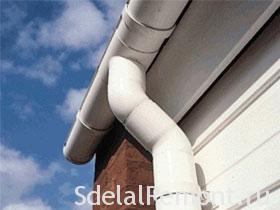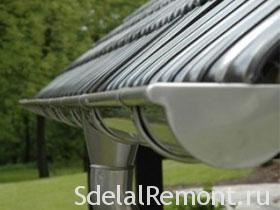The constituent parts are downpipes:
- rainwater;
- knee to bypass the projections on the wall;
- direct links;
- otmot to divert water from the walls of the building.
The main parts include rainwater:
- rim;
- cone;
- glass.
What is needed to make
If you want to make the installation of drain pipes with their own hands, the:
- To perform the rim of the funnel is cut blank, having a width, equal to the length of the upper side of the trapezoidal blanks cone, then the edges are bent for connecting with the cone.
- Thereafter, the workpiece is bent and connected rebated.
- Then roll out two roll stiffness on the finished beads and rim edge, in which the roll having a diameter 14 mm wire.
- Required for the cone shaped cut blank of an isosceles trapezoid. Its upper side along the length must be equal to the width of the workpiece to nozzle, and the lower side length must correspond to the width of the rim preform.
- At first, the resulting preform should fold seamed edge, and then when you need to bend the shaft deflected roll it into a cone on the rolling of. The cone of the generator must be connected to a fold.
- The edges of the rectangular blank cups should be connected and tighten. At the final stage of a glass tube is inserted into the unit.

Material for direct links downpipes are standard steel sheets, which depending on the diameter of the drain pipe and the desired number of links are cut across or along the. Then the blank is brought into slight taper, shortening one of its sides by 5-6 mm. This is necessary in order, ready to links well into each other.
The preform element with bent edges for rebate manually roll on a steel pipe, Brusa repair or vykatyvaût the valʹcovke.
In the folding machine to roll out of direct links ends protruding above the surface level of 7-8 mm rolls. They limit the depth of the approach one unit to another and are ribs.
Elbows are:
- corrugated, a direct link made of pipe, is folded with a press;
- non-corrugated, made of multiple tube units.
To make otmot, take smooth knee with obliquely cut-off lower end.
- Fastening rainwater heads and downpipes by using curtain wall and the staple pins. A fastening band for fastening the funnel intended Coffer pin bends and thus shorten, to an inlet cone of the funnel was located 7-10 mm below the drip eave, and roll stiffness of the funnel glass was based on a collar pin.
- Fixing pin carried top wall just below the upper transition knee, and the bottom - just above noted. Between them at regular intervals set additional pins, if necessary. Pins fastened to clog the holes flush with the wall of birch jams.
Special skills and experience to work with serrated iron does not require, and so new to this business can get out of it high-quality products. This requires an ornament or pattern and a minimum set of tools, which includes:
- hammer;
- Metal shears;
- marking gauge;
- elbow;
- ruler;
- several sechek.
For sheet metal marking gauge is in the form of a plate, made of hardened steel. The tool has a notch on both edges. With thicknesser draws a sheet edges parallel marking lines.
Broken rice should be of three types:
- semicircular;
- round;
- direct.
Chaff is made of round having a desired diameter hardened stainless steel tube. Their working part has good sharpening, and on top of a stub, designed to strike a hammer. In these guest Sechko serving for material removal opening fragments. Chaff produced 150-180 mm.
Chaff semicircular shape may have different cross-sectional: sloping, steep or secondary. Working side sharpened by the width 3,5-30 mm. You can make a tool and at home. To this end, a conventional chisel remove the working part, and then attach it back semicircular shape with emery wheel. At the edge of the same circle of performing the work of the tool, which was later sharpened.
Chaff straight chisels can be simple with the working edge width from 8 to 30 mm and a tapering angle of - 35 ° to 40 °.
any necessary tool, including broken rice, It can be made independently with the proviso ownership heat treatment skills steel.
Typically, this type of work taking:
- black;
- galvanized iron roofing.
It is preferable to use a black iron, because it stands out more clearly after staining pattern, black. However, this type of iron is, and the lack of, which is, it, Unlike galvanized iron, pretty quickly rust.
Made on galvanized iron grooved pattern begins to "play" on the brick wall background, as well as in the case, if the wall of the house and the roof painted in dark colors.
Installation of drainage pipes with their own hands
 Workplace Preparation
Workplace Preparation
Before you begin any of the works, you must carefully prepare the workplace:
- To do this, find a beech or oak block of wood and put it on a stable bench. Iron prosekayut should be on top of the block of wood.
- Tinsmith sits on the bench top so, block of wood that was between his legs.
- On one level, with the right block of wood set box of small size, and the left - table. The table is designed for the storage of tools, and goats are necessary for the horizontal arrangement of long sheets grooved thread.
Working process
How do the openings provided in advance harvested pattern:
- prosekayut first on the surface that you partition using gon, rulers and other tools;
- sheet is then placed on the block of wood;
- all holes are punched chaff, hitting them with a hammer.
The most difficult parts are punched semicircular Sechko. Picture, pattern at the edges cut with scissors for metal, and internal - direct sliced.
For punching small holes, in addition to the listed tools, They may need battle-axes.
Blackening grooved iron
Expanded iron trim by its oxidation, ie blackening. Blackening is conducted using heated in an enamel pot. However, it is important to note, it is quite difficult to blacken grooved sheets, having a large size.
Before blackening previously prepared iron: removed from it rust and scale in the following solutions:
- formalin - 2 parts;
- 20%-Naya hydrochloric acid - 48 parts;
- urotropin - 0,5 pills; 20%-Naya hydrochloric acid - 0,5 l;
- solyanaya acid - 25 parts; sulphuric acid - 15 parts; urotropin - 0,06 parts;
- water - 200 parts.
Also watch the video, how the installation of drainage system with their own hands:












